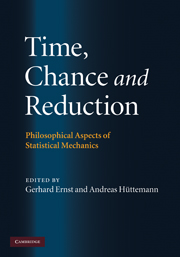9 - Reduction and renormalization
from Part III - Reduction
Published online by Cambridge University Press: 04 August 2010
Summary
Introduction
In this chapter I want to consider the so-called reduction of thermodynamics to statistical mechanics from both historical and relatively contemporary points of view. As is well known, most philosophers not working in the foundations of statistical physics still take this reduction to be a paradigm instance of that type of intertheoretic relation. However, numerous careful investigations by many philosophers of physics and physicists with philosophical tendencies show this view is by and large mistaken. It is almost surely the case that thermodynamics does not reduce to statistical mechanics according to the received view of the nature of reduction in the philosophical literature. What is interesting is that, while not framing the issue in these terms, J. Willard Gibbs can also be seen as being somewhat sceptical about the possibility of a philosophical reduction of thermodynamics to statistical mechanics. Gibbs' scepticism is, of course well-known. Nevertheless, I think his remarks bear further consideration given certain advances in understanding the foundations of statistical physics.
I will first briefly run over some philosophical ground, outlining the received approach to theory reduction as well as what I take to be a more promising conception of reduction that parallels, to some extent the way physicists typically speak of theory reduction. Following this I will discuss Gibbs' famous caution in connecting thermodynamical concepts with those from statistical mechanics. This is presented in chapter XIV, ‘Discussion of Thermodynamic Analogies’, of his book Elementary Principles in Statistical Mechanics.
- Type
- Chapter
- Information
- Time, Chance, and ReductionPhilosophical Aspects of Statistical Mechanics, pp. 159 - 179Publisher: Cambridge University PressPrint publication year: 2010
References
- 7
- Cited by



